In a world where technology evolves at breakneck speed, artificial intelligence has emerged as a pivotal force shaping how we interact with information and each other. Among the most remarkable advancements in this arena is ChatGPT 5, a sophisticated iteration of OpenAI’s conversational AI. This blog post will explore what ChatGPT is, its capabilities, and how it can serve as your new AI companion, particularly in fields like education and beyond.
What is ChatGPT?
ChatGPT, developed by OpenAI, is a state-of-the-art language model that employs deep learning techniques to understand and generate human-like text. This powerful tool engages users in conversation, answers questions, and provides information on a vast range of topics.
Key Features of ChatGPT
- Natural Language Processing (NLP): At its core, ChatGPT is built on advanced NLP technologies. This allows it to comprehend context, nuances, and subtleties in human language, making interactions feel more natural and less robotic.
- Context Awareness: One of the standout features of ChatGPT is its ability to maintain context throughout a conversation. This means that if you ask a follow-up question, ChatGPT can refer back to previous exchanges, creating a more coherent dialogue.
- Versatility: ChatGPT’s applications are nearly limitless. Whether you need assistance with writing, brainstorming ideas, or tackling complex subjects, this AI adapts to your specific needs. Its extensive knowledge base covers everything from science and technology to culture and history.
- Continuous Learning: Unlike static models, ChatGPT 5 continually learns from user interactions and incorporates feedback, enhancing its understanding of language and improving its responses. This means that with each conversation, it becomes better equipped to understand what users want.
How ChatGPT Works
ChatGPT operates on a transformer-based architecture, a type of neural network particularly well-suited for language tasks. Here’s a closer look at its functionality:
- Training: The model undergoes extensive training on diverse datasets, which include books, articles, and websites. This exposure helps it learn grammar, facts, and even some reasoning abilities. The training process involves processing vast amounts of text to identify patterns in language use.
- Inference: When you input a question or prompt, ChatGPT analyses it and generates a coherent response based on its training. It predicts the most likely continuation of the conversation, drawing from the patterns it has learned.
- Fine-Tuning: OpenAI employs a method called reinforcement learning from human feedback (RLHF) to refine ChatGPT’s outputs. Human reviewers evaluate the model’s responses and provide feedback, helping it align more closely with user expectations.
The Evolution from Previous Versions
ChatGPT 5 builds upon the strengths of earlier iterations, addressing their limitations and enhancing user experience. Improvements include:
Do you want to know about AI Memes - Read More
- Greater Accuracy: With a refined understanding of context and nuance, ChatGPT 5 provides more precise and relevant answers.
- Broader Knowledge Base: The model has been trained on various topics, enabling it to engage in conversations across more subjects.
- Improved User Interaction: The AI now better understands conversational cues, making it more adept at following the natural flow of dialogue.
ChatGPT as an Astronomy Teacher

Imagine having an AI companion that can explain the mysteries of the universe. This is where ChatGPT 5 truly shines, particularly in astronomy. Its capability to serve as an astronomy teacher can transform how you learn about the cosmos.
Exploring the Cosmos with ChatGPT
- Interactive Learning: Learning about astronomy can sometimes feel daunting, especially with the information available. Rather than passively reading textbooks, you can engage in real-time discussions with ChatGPT 5. For example, if you’re curious about black holes, you could ask:
“What are black holes, and how do they form?”
In response, ChatGPT 5 would provide a detailed explanation, covering the formation of black holes from collapsing stars, the concept of the event horizon, and their significance in the universe.
- Tailored Content: ChatGPT can adjust its responses based on your level of expertise. If you’re just starting, it might introduce basic concepts like gravity and light years. For more advanced learners, it could delve into complex theories like general relativity or quantum mechanics.
- Visual Aids and Resources: While ChatGPT primarily provides text-based responses, it can recommend visual aids and resources to enhance your understanding. For instance, if you’re exploring the lifecycle of stars, it might suggest diagrams or videos that illustrate the processes involved.
Case Study: Learning About the Solar System
Let’s consider a practical example: a student named Alex is preparing for a school project on the solar system. Here’s how Alex could leverage ChatGPT 5 in this learning journey:
- Initial Inquiry: Alex begins by asking, “Can you give me an overview of the solar system?”
- Detailed Response: ChatGPT responds with a structured summary, including information about the sun’s role, the planets, their moons, and other celestial bodies like asteroids and comets.
| Celestial Body | Key Facts |
| Sun | The center of our solar system, a massive star. |
| Mercury | The closest planet to the sun, with extreme temperatures. |
| Venus | Known for its thick, toxic atmosphere and runaway greenhouse effect. |
| Earth | The only known planet to support life. |
| Mars | Often called the Red Planet, known for its potential for past life. |
| Jupiter | The largest planet, famous for its Great Red Spot. |
| Saturn | Known for its stunning rings made of ice and rock. |
| Uranus | An ice giant with a unique sideways rotation. |
| Neptune | The farthest planet, known for its deep blue colour. |
- Deep Dives: If Alex wants to know more about Mars, he could ask, “What’s unique about Mars compared to Earth?” ChatGPT 5 would explain aspects such as Mars’ thin atmosphere, surface features, and its potential for past life, providing a well-rounded understanding.
- Project Ideas: Finally, Alex seeks suggestions for his project. ChatGPT 5 could offer creative ideas, such as creating a scale model of the solar system or producing a multimedia presentation comparing the planets’ atmospheres.
Benefits of Using ChatGPT in Astronomy Education
Using ChatGPT 5 as an educational tool offers several advantages:
- Accessibility: ChatGPT is available 24/7, allowing you to learn at your own pace and convenience. Whether it’s day or night, your AI companion is ready to help.
- Engagement: The conversational format keeps learning dynamic and engaging, which is particularly beneficial when tackling complex subjects like astronomy.
- Resourcefulness: ChatGPT can help you find additional resources, such as online courses, articles, and videos, to supplement your learning.
Do you know about goldman sachs - Read More
Limitations to Consider
While ChatGPT 5 is a powerful educational tool, it’s essential to be aware of its limitations:
- Accuracy: Although ChatGPT aims for accuracy, it can sometimes provide outdated or incorrect information. Always cross-check details, especially in scientific contexts.
- Depth of Knowledge: For very advanced topics, ChatGPT might provide general information but lack the depth that an expert in the field could offer.
- Dependence on Input Quality: Your questions’ clarity and specificity greatly influence the responses’ quality. Clear, well-phrased inquiries typically yield the best results.
ChatGPT in Other Educational Contexts

Beyond astronomy, ChatGPT 5 can be a valuable resource in various educational fields. Here are some examples of how it can enhance learning in other subjects:
Language Learning
- Conversational Practice: ChatGPT can simulate conversations in different languages, allowing learners to practice speaking, writing, and comprehension skills. You can engage in dialogues on various topics, receiving instant feedback on grammar and vocabulary.
- Cultural Insights: Language learning is not just about vocabulary; it’s also about understanding cultural nuances. ChatGPT can provide insights into customs, idioms, and expressions, making the learning experience richer and more immersive.
History
- Interactive Storytelling: ChatGPT can bring historical events to life through engaging narratives. By asking about a specific event or period, you can receive a detailed account, complete with context and significance.
- Research Assistance: Need help finding sources for a history paper? ChatGPT can help identify key figures, events, and primary sources, guiding your research process.
Science and Technology
- Concept Explanations: Whether you’re studying biology, chemistry, or physics, ChatGPT can break down complex concepts into digestible pieces. You can ask for explanations of theories, chemical reactions, or scientific principles, and receive clear, concise answers.
- Problem Solving: If you’re struggling with a math or science problem, ChatGPT can guide you through the steps needed to find a solution, helping you understand the process rather than just providing the answer.
Creative Writing
- Brainstorming Ideas: Stuck on your next writing project? ChatGPT can help generate ideas, plot outlines, or character descriptions, sparking your creativity and getting your ideas flowing.
- Feedback and Editing: If you want feedback on your writing, you can share excerpts with ChatGPT. It can offer suggestions for improvement, help with grammar, and provide constructive criticism.
Final Thought
ChatGPT 5 represents a significant leap forward in artificial intelligence, particularly in its role as an educational companion. Whether you’re diving into the complexities of astronomy or exploring other subjects, ChatGPT 5 can make learning more engaging and accessible. With its ability to provide tailored content, maintain context, and offer real-time feedback, it serves as a valuable resource for learners of all ages.
As we continue to explore the potential of ChatGPT 5 in various educational contexts, the next section will delve into more specific applications and use cases, uncovering how this innovative AI can transform education even further. Stay tuned for the exciting possibilities that lie ahead!









